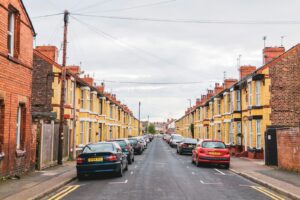Why aren’t locals benefiting from Margate’s regeneration?

Margate from above. Copyright John Fielding. Flickr.
Margate is often heralded as a regeneration success story, but locals who have lived in the town for decades are feeling priced out. Aimée Grant Cumberbatch reports.
Like many seaside towns in the UK, Margate was a popular destination, first for wealthy Georgians and Victorians seeking sea-bathing cures, then for holiday-makers from London and the South East, who found sea and sand, if not always sun, practically on their doorstep.
With an amusement park, a sea lido and a concert hall, Margate’s appeal was obvious right up until the 1960s and early 70s.
But in a now-familiar story, the advent of affordable package holidays to more reliably sunny destinations turned Margate’s fortunes, and many of the once lively guest houses, hotels, and attractions, which provided jobs for local people, closed down.
Over the past 10 years this has been changing, with the arrival of a high-speed rail link from London St Pancras, which reached the town in 2009, and the opening of the Turner Contemporary art gallery in 2011, which revivified Margate’s art scene.
New shops and restaurants followed, and so did people priced out of the capital, armed with London salaries and a desire to snap up Margate’s comparatively affordable period properties. Thanet District Council (TDC) even has a scheme where it offers grants of up to £25,000 to those wishing to renovate empty buildings.
Growing pains
While on paper this may read like a fairytale of regeneration, there are growing pains. The increase of newcomers from the capital has helped house prices soar over the last decade, by up to 55% in some areas of Margate.
However, now there are tensions between three of its distinct communities: the ‘Down From Londoners’ or ‘DFLs’ as they’re nicknamed locally, those who lived in Margate prior to its regeneration, and migrants from European countries.
These tensions are often seen on local Facebook groups where ‘DFLs’ are sometimes mocked for their propensity to swim in the Walpole Bay tidal pool year round, or long-term residents of Margate are criticised for allowing the town’s heritage to fall into disrepair. But while this may seem relatively light-hearted, there are signs that resentment runs deeper. One picture which surfaced in a Margate Facebook group that showed ‘DLF C**** F*** Off’ written in the snow on someone’s car.
A backlash against migration in the area came to a head prior to the EU referendum, with TDC coming under the control of UKIP in 2015. However, support for the party appears to be on the wane in Margate, with UKIP losing control of the council in 2018 and Labour and Conservatives winning seats in the Margate and Cliftonville wards in 2019.
Angela Baybrook, who at 67 has lived in Margate all her life, doesn’t feel newcomers are to blame for housing issues. ‘The majority [of newcomers] are [good for the area],’ she says.
‘Just look at Cliftonville and the shops. Also, a couple of farms employ many European people, not forgetting our NHS. I am not one of these people who say, “These foreigners have taken our housing and jobs away”.’
The changes brought about by regeneration are largely welcomed by the long-term residents I spoke to. But there was a feeling that the council isn’t doing enough to provide for those who rely on social housing as prices rise.
Kathleen Leech, who has lived in Margate for 18 years, has been on the social housing waiting list for two years. Despite this, she has never heard of TDC’s flagship housing scheme Live Margate.
She says: ‘There is a lack of social housing and help for those who have no choice but to go private. There’s a lack of money for this area, as well as not enough homes under social housing.’
Baybrook adds, ‘I have seen the area slowly die. Places like the Lido employed people all year round. All our parks are losing their gardens, ponds and cafes. Council houses are being sold with the idea to help build other social housing.’
Affordability
The council does appear to be making some effort to improve housing provision in the area. The website for the Live Margate scheme states ‘£23.1m will be used to buy up properties in the area, to increase the number of family homes, improve living and housing standards, and encourage investment and owner occupation.’
When NewStart asked a representative of the council how much of the ‘high quality’ housing will be allocated to those on low incomes, they responded: ‘TDC’s contribution to Live Margate is used to provide affordable rented homes for households on the council’s register.’
They continued: ‘So far there are seven completed projects and two more projects on site. These nine projects have taken on empty and derelict buildings and will provide a total of 32 new affordable rented family homes. The council has funding allocated for a further Margate Housing Intervention project in Cliftonville.’
However, if the rising house prices mentioned earlier are taken into account, ‘affordable’ may not mean what it did a decade ago. New homes built in the area are likely to have rents in line with these increases which could leave residents, who may not have seen a similar rise in wages over the same time period, struggling to meet the difference. As per a 2018 report from Kent County Council, Thanet has the second lowest weekly wages in the Southeast.
TDC also admits it does not have enough social housing allocation to cover demand. A representative said, ‘TDC owns 3,027 social and affordable housing rented homes across Thanet and works with housing associations who also provide social and affordable rented homes.
‘However, this supply does not meet local need. There are currently 2,369 households on our housing register waiting for a social or affordable rented home.’
If supply outstrips demand, this could in part be due to the way housing is allocated. Owner of Cooke & Co estate agents Damien Cooke, who has lived in Margate for 48 years, believes the council gives some of its social housing provision to those from London boroughs.
He explains, ‘Let’s say, you’re in a London block of flats that a private developer buys. If you’re in social housing you can be [sent] down to Thanet. The London councils will offload social housing so that these wealthy property developers don’t have [to make] provision in the place they’re building. They offer people incentives to move to another area, be it Thanet or somewhere else.’
This is a concern echoed by Baybrook, who comments, “I don’t believe our council are active enough. For many, many years we have given our social housing to boroughs like Lambeth. They pay our council so much per family that moves down here.”
Priced out
When asked, TDC denied ever giving social housing allocation to London boroughs. However, there have been documented cases of those who rely on social housing in the capital being relocated elsewhere, including to locations on the South Coast like Hastings.
There is also London’s Seaside & Country Homes Scheme, which as per its website, ‘offers older tenants of London’s councils and housing associations the opportunity to move away from the hustle and bustle of the city.’ In the scheme’s Areas and Properties Guide, the Thanet towns of Margate and Ramsgate are listed as locations where prospective tenants may be able to move.
Regeneration in Margate rumbles on — a new attraction in the form of the Margate Caves is to open later this year, and a ‘Save Margate Lido’ project is underway. But amid the many positives, there are those who feel the pace of change is leaving them behind, and that TDC’s approach to housing is doing little to stop them being priced out of an area they may have lived in for decades.















